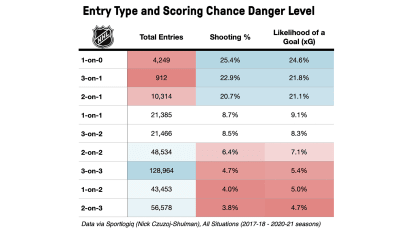What we see here is that in addition to where a shot comes from, any kind of skater advantage in terms of number of players can make a big difference. A "normal shot" has an 8.15% likelihood of becoming a goal. The minute an opponent gets an extra skater on an attack, that likelihood almost triples - a huge increase in difficulty. Similarly, if you are on defense and have more skaters directly involved, you can cut difficulty by up to almost 50%.
And perhaps this is why Dave Hakstol has not just made stopping rush chances a priority, but why he's not going to lay responsibility for rush chances against solely at the feet of any goaltender.
"When we do have those (outnumbered) rushes we need to find a way to defend and get a stop," Hakstol said. "Getting stops is a team conversation. The forward tracking the puck can make a play, the defenseman can do a little bit better defending and a group of five before it gets to the goaltender."
A netminder definitely has a responsibility as the last line of defense, but there are steps a team can take in front of her or him to decrease the difficulty of any chance against. As the Kraken look to clean up the "mistakes" in their game, rush chances, given their degree of difficulty in terms of what we see and what the data tells us, rightly need to remain an area of focus
"We have to find a way to eliminate odd-man rushes and we have to find a way to be in more sync and play better as a team," Jordan Eberle said. "It's that simple."



























